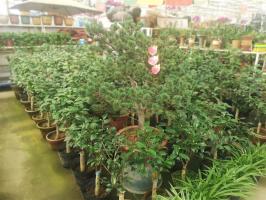How to Care for a Basil Potted Plant
Basil is a popular herb used in cooking and also for medicinal purposes. It is also a great plant to grow indoors as it can thrive in a potted environment. However, to ensure the health of your basil plant, it's essential to understand the proper care requirements. In this article, we'll guide you through how to care for a basil potted plant adequately.
Lighting Requirements
Basil plants require a considerable amount of light to grow healthily. They need at least six hours of sunlight every day. If grown indoors, place your basil plant in a south-facing window to ensure it gets enough sunlight. Suppose your window doesn't get enough sunlight. In that case, you can use fluorescent grow lights specially designed for plants to provide adequate light.
Watering Requirements
Basil plants need to be watered regularly to ensure their soil is always moist. Water your basil plant twice a week if planted in a well-draining soil mixture. If your soil mixture drains poorly, ensure you don't overwater the plant to avoid waterlogging, which is harmful to basil. When watering the plant, pour the water slowly and evenly over the soil until water spills out of the drainage hole. Always use room temperature water to avoid shocking the plant with cold water.
Temperature and Humidity
Basil plants require specific temperature and humidity conditions to grow well. The ideal temperature for a basil plant is between 70-85°F (21-29°C). Avoid exposing your basil plant to extreme temperatures, such as frost or heatwaves. You need to ensure your basil plant is in a place with controlled temperature and humidity levels. If you live in an area with dry air, you can place a tray of water near your basil plant to create humidity. Alternatively, you can use a humidifier to maintain the perfect humidity level.
Fertilizing Requirements
Basil plants require regular fertilizing to supplement the nutrients they require for healthy growth. Organic fertilizers, such as compost or manure, are ideal for basil plants. Fertilize your plant once every two weeks during its growing season. Avoid using chemical fertilizers as they tend to harm your basil plant. Symptoms of over-fertilization include yellowing leaves, leaf burn, and stunted growth.
Pruning and Harvesting
Regular pruning is essential in ensuring your basil plant remains bushy and healthy. Remove any yellowing or dead leaves, as they can lead to the spread of diseases. When harvesting your basil plant, use clean, sharp scissors to avoid injuring the stem or the surrounding leaves. Harvest from the top down, taking care not to remove more than a third of the plant in one go. Prune your basil plant regularly to encourage bushy growth and frequent harvesting.
Conclusion
Basil plants are a great herb to grow in a potted environment. However, they require the right care to remain healthy and bushy. Light, watering, temperature and humidity, fertilizing, and pruning and harvesting are critical aspects of caring for a basil plant. With these care tips, you can have a healthy basil potted plant that will thrive and provide you with fresh herbs for your culinary and medicinal needs.

 how many times do yo...
how many times do yo... how many planted tre...
how many planted tre... how many pine trees ...
how many pine trees ... how many pecan trees...
how many pecan trees... how many plants comp...
how many plants comp... how many plants can ...
how many plants can ... how many plants and ...
how many plants and ... how many pepper plan...
how many pepper plan...






























